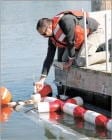Scientists aim to create biofuel
Tiny green algae grown in floating plastic bags may one day wean us from our voracious fossil fuel consumption.
Such is the vision of Jonathan Trent, a scientist at NASA’s Ames Research Center who created the Offshore Membrane Enclosures for Growing Algae, or OMEGA, project. Trent hopes to revolutionize biofuel production by farming algae in the ocean, creating a system that can also remove excess nutrients from wastewater and reduce carbon dioxide emissions.
“It’s really all about closing loops in a life support system,” said Trent, who has a doctorate in biological oceanography from the Scripps Institution of Oceanography. He hopes to develop an “ecology of technology,” where waste products from one system become the raw materials that drive another system.
Trent views the search for fossil fuel alternatives as a pressing issue.
“We need to stop hunting and gathering our energy, and need to start cultivating our energy,” he said.
Growing large quantities of microalgae on land, enough to power cars and planes, would compete with agriculture for space, water and fertilizer — something Trent considers a nonstarter. That’s where the “offshore” part of OMEGA comes in.
The ocean provides a spacious, temperature-controlled environment to grow algae, with it’s own ready stream of nutrients: wastewater released from sewage treatment plants. Trent envisions algae grown in the OMEGA system treating the wastewater by taking up excess nitrogen and phosphorous for their growth.
Trent’s conception for the OMEGA project began in 2008, and since 2010 he and his research team have had the help of an $800,000 grant from the California Energy Commission, and additional support from NASA’s Aeronautics Research Mission Directorate.
“The proposal was a unique and elegant solution,” said Adam Gottlieb, a spokesman at the California Energy Commission. “It has the potential to solve the technical challenges about cultivating algae, and potentially doing it cheaper. It quite possibly could be a game changer.”
The team is currently developing and testing prototype bags for growing algae at the California Department of Fish and Game facility in Santa Cruz. They are also conducting tests in Moss Landing Harbor and at the Southeast Water Pollution Control Plant in San Francisco.
Testing the system
To produce the fuel of the future, researchers focus on freshwater microalgae — green, free-floating single cells that can multiply once a day.
The system the team is testing in Santa Cruz consists of four 10-foot-long, clear plastic bags that float at the water’s surface. Pumped water circulates through the plastic structures, and the microalgae inside harness the energy of sunlight through photosynthesis. By taking in carbon dioxide and expelling oxygen, Trent said a bag full of algae functions as a type of “reverse lung.”
A small portion of the water continuously flows through a column that is open to the air, allowing excess oxygen to escape. While the researchers currently bubble pure carbon dioxide into this gas exchange column to feed the algae, they are developing methods to capture carbon dioxide from flue gas, which would reduce emissions to the atmosphere.
As the algae grow and multiply, the team harvests their micro-crop every other day and primes the system with a fresh batch of starter algae. They are trying to maximize algal growth with minimum energy input.
Meanwhile, at Moss Landing
While the scientists are testing their designs in enclosed pools, they are also considering what might happen once the system moves to the ocean. They question whether seaweeds that colonize the outside of the bag will sink the structure or block sunlight from reaching the algae, and whether the bags pose a threat to wildlife, and vice versa.
To find answers, the researchers have attached a 30-foot-long OMEGA bag to one of the docks at the Moss Landing Marine Laboratories boat facility in Moss Landing Harbor. No algae are growing inside this bag — the researchers simply want to observe the structure.
Every week, the team counts the amount of fouling organisms on the outside of the bag, and monitors the activity of birds and mammals around the bag with the help from graduate students at Moss Landing Marine Laboratories.
OMEGA scientist Linden Harris said the ultimate goal of the project is to benefit the environment, so it is important to investigate potential detrimental effects.
“I think a lot of people have been a little freaked out about … putting tons of plastic in the ocean and altering the environment,” she said. “And that’s a valid concern, so we just want to be able to say, ‘This is exactly how we think it will affect the environment.'”
Not sea trash
Trent said the OMEGA system is far from ocean trash.
Bookmark this page for “algae farming” and check back regularly as these articles update on a very frequent basis. The view is set to “news”. Try clicking on “video” and “2” for more articles.








